
WHICH NATIVE WILL YOU CHOOSE?![]()
![]()
Motivation
![]() Why Natives
Why Natives
![]() Garden Goals
Garden Goals
Site Preparation
![]() Site Analysis
Site Analysis
![]() Site Plan
Site Plan
![]() Hardscapes
Hardscapes
Plant Selection
![]() Which Native
Which Native
![]() Planting Hints
Planting Hints
![]() Suggested Plants
Suggested Plants
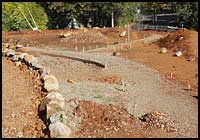
Red clay soil holds water in the winter and bakes hard in the summer sun.
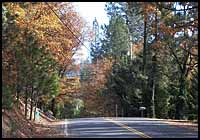
The oaks and pines are lovely to look at, but they may limit plant choices due to too much shade.

This native bush lupine at the edge of a bank is very happy in its location in the foothills.
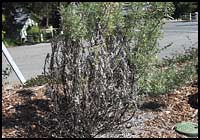
This bush lupine, located only a few feet away, had a problem during the winter. Probably it wasn't the cold weather but more likely it was too much water that tended to pool in the slight depression in this area.
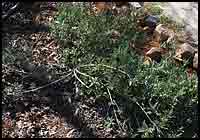
This Cleveland sage, native to Southern California, grew robustly in the summer and retained its color all winter. However, a load of snow broke one of its branches. Snow is relatively uncommon at this elevation.
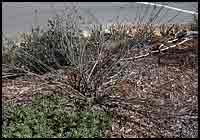
This Cleveland Sage, planted a few feet away, was robust in the summer with lovely flowers, but it didn't survive the winter. It may have been too cold or too wet. The healthy mallow plant next to the sage continued to increase in size all winter and bloomed early in the spring.
Which Native?
Define “Native”
With your personal aims established and the work on the ground completed, you are ready to consider specific plants. However, you must first answer the question, “Native to where?”
Your choices include:
-
only those plants that are native to the foothills of the Sierra Nevada
-
plants that are native somewhere in California
-
plants that are native somewhere in the United States
-
a combination of California or U.S. native plants and those from other countries
-
mostly California native plants along with other plants that appeal to you
Mediterranean Climate
California has a “Mediterranean climate” named for the climate found in the countries bordering the Mediterranean Sea. This climate is characterized by warm to hot, dry summers and cool, wet winters. It is also found in South Africa, western and southern Australia and central Chile. Native plants from these countries are likely to thrive as well in the Sierra Nevada foothills as they do in their home countries. Some plants go dormant in the summer, some in winter, and some are green all year.
Foothill elevations range from about 300 feet to 2,000 feet. Annual precipitation of 18 to 45 inches or more occurs mostly from late fall to early spring. Summer temperatures are often in the high 90s and higher. Soils in the foothills vary from clay to forest soils to serpentine. Read the Western Nevada County Gardening Guide for more understanding of soil types. Red clay soil will bake hard and dry in the summer, but can be mucky and unworkable in the winter. Areas of serpentine soil may limit plant choices.
Although this website focuses on gardening in the foothills with the usual red clay, much of the information concerning landscape decisions will apply to the valley grasslands below or the Sierra zones above the foothills.
Finding the Right Location
Practical experience has shown that success with a plant may vary due to a variety of conditions, including the elevation of the property, the composition of the soil, wind exposure, moisture content, and shelter from frost and snow. Books listed in the Resource section will be helpful in deciding where to place a plant in your garden.
-
Know the Sunset or USDA zone in which you live and read the plant’s description to learn whether it should be appropriate to your zone. The foothills are Zone 7 in the Sunset Western Garden Book and USDA Zone 8.
-
Note the native conditions under which the plant naturally grows, such as dry sandy soils or moist woodlands.
-
Locate “microclimates” on your property where the growing conditions might be more favorable for the plant.
-
Check the expected mature size of the plant to see if it is appropriate to the location.
If a plant is appealing to you but borderline for your zone, plant it in your garden anyway and see what happens. Sometimes experiments work out well.